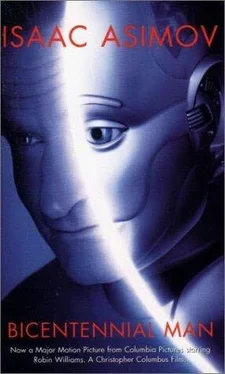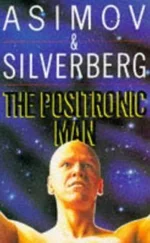“And you think that if you introduce the effect into the robotic brain, the human brain will become not superior to the robotic brain in principle.”
“That,” said Madarian, “is exactly what I believe.”
They went on for a long time after that.
The Board of Directors clearly had no intention of being easily convinced.
Scott Robertson, the largest shareholder in the firm, said, “It’s hard enough to manage the robot industry as it is, with public hostility to robots forever on the verge of breaking out into the open. If the public gets the idea that robots will be uncontrolled . . . Oh, don’t tell me about the Three Laws. The average man won’t believe the Three Laws will protect him if he as much as hears the word ‘uncontrolled.’ ”
“Then don’t use it, “ said Madarian. “Call the robot—call it ‘intuitive.’ ”
“An intuitive robot,” someone muttered. “A girl robot?” A smile made its way about the conference table.
Madarian seized on that. “All right. A girl robot. Our robots are sexless, of course, and so will this one be, but we always act as though they’re males. We give them male pet names and call them he and him. Now this one, if we consider the nature of the mathematical structuring of the brain which I have proposed, would fall into the JN-coordinate system. The first robot would be JN-1, and I’ve assumed that it would be called John-1. . . . I’m afraid that is the level of originality of the average roboticist. But why not call it Jane-1, damn it? If the public has to be let in on what we’re doing, we’re constructing a feminine robot with intuition.”
Robertson shook his head, “What difference would that make? What you’re saying is that you plan to remove the last barrier which, in principle, keeps the robotic brain inferior to the human brain. What do you suppose the public reaction will be to that?”
“Do you plan to make that public?” said Madarian. He thought a bit and then said, “Look. One thing the general public believes is that women are not as intelligent as men.”
There was an instant apprehensive look on the face of more than one man at the table and a quick look up and down as though Susan Calvin were still in her accustomed seat.
Madarian said, “If we announce a female robot, it doesn’t matter what she is. The public will automatically assume she is mentally backward. We just publicize the robot as Jane-1 and we don’t have to say another word. We’re safe.”
“Actually,” said Peter Bogert quietly, “there’s more to it than that. Madarian and I have gone over the mathematics carefully and the JN series, whether John or Jane, would be quite safe. They would be less complex and intellectually capable, in an orthodox sense, than many another series we have designed and constructed. There would only be the one added factor of, well, let’s get into the habit of calling it ‘intuition.’ ”
“Who knows what it would do?” muttered Robertson.
“Madarian has suggested one thing it can do. As you all know, the Space Jump has been developed in principle. It is possible for men to attain what is, in effect, hyper-speeds beyond that of light and to visit other stellar systems and return in negligible time-weeks at the most.”
Robertson said, “That’s not new to us. It couldn’t have been done without robots.”
“Exactly, and it’s not doing us any good because we can’t use the hyper-speed drive except perhaps once as a demonstration, so that U. S. Robots gets little credit. The Space Jump is risky, it’s fearfully prodigal of energy and therefore it’s enormously expensive. If we were going to use it anyway, it would be nice if we could report the existence of a habitable planet. Call it a psychological need. Spend about twenty billion dollars on a single Space Jump and report nothing but scientific data and the public wants to know why their money was wasted. Report the existence of a habitable planet, and you’re an interstellar Columbus and no one will worry about the money.”
“So?”
“So where are we going to find a habitable planet? Or put it this way—which star within reach of the Space Jump as presently developed, which of the three hundred thousand stars and star systems within three hundred light-years has the best chance of having a habitable planet? We’ve got an enormous quantity of details on every star in our three-hundred-light-year neighborhood and a notion that almost every one has a planetary system. But which has a habitable planet? Which do we visit? . . . We don’t know.”
One of the directors said, “How would this Jane robot help us?”
Madarian was about to answer that, but he gestured slightly to Bogert and Bogert understood. The Director would carry more weight. Bogert didn’t particularly like the idea; if the JN series proved a fiasco, he was making himself prominent enough in connection with it to insure that the sticky fingers of blame would cling to him. On the other hand, retirement was not all that far off, and if it worked, he would go out in a blaze of glory. Maybe it was only Madarian’s aura of confidence, but Bogert had honestly come to believe it would work.
He said, “It may well be that somewhere in the libraries of data we have on those stars, there are methods for estimating the probabilities of the presence of Earth-type habitable planets. All we need to do is understand the data properly, look at them in the appropriate creative manner, make the correct correlations. We haven’t done it yet. Or if some astronomer has, he hasn’t been smart enough to realize what he has.
“A JN-type robot could make correlations far more rapidly and far more precisely than a man could. In a day, it would make and discard as many correlations as a man could in ten years. Furthermore, it would work in truly random fashion, whereas a man would have a strong bias based on preconception and on what is already believed.”
There was a considerable silence after that Finally Robertson said, “But it’s only a matter of probability, isn’t it? Suppose this robot said, ‘The highest-probability habitable-planet star within so-and-so light-years is Squidgee-17” or whatever, and we go there and find that a probability is only a probability and that there are no habitable planets after all. Where does that leave us?”
Madarian struck in this time. “We still win. We know how the robot came to the conclusion because it—she—will tell us. It might well help us gain enormous insight into astronomical detail and make the whole thing worthwhile even if we don’t make the Space Jump at all. Besides, we can then work out the five most probable sites of planets and the probability that one of the five has a habitable planet may then be better than 0.95. It would be almost sure—”
They went on for a long time after that.
The funds granted were quite insufficient, but Madarian counted on the habit of throwing good money after bad. With two hundred million about to be lost irrevocably when another hundred million could save everything, the other hundred million would surely be voted.
Jane-1 was finally built and put on display. Peter Bogert studied it—her—gravely. He said, “Why the narrow waist? Surely that introduces a mechanical weakness?”
Madarian chuckled. “Listen, if we’re going to call her Jane, there’s no point in making her look like Tarzan.”
Bogert shook his head. “Don’t like it. You’ll be bulging her higher up to give the appearance of breasts next, and that’s a rotten idea. If women start getting the notion that robots may look like women, I can tell you exactly the kind of perverse notions they’ll get, and you’ll really have hostility on their part.”
Madarian said, “Maybe you’re right at that. No woman wants to feel replaceable by something with none of her faults. Okay.”
Читать дальше












